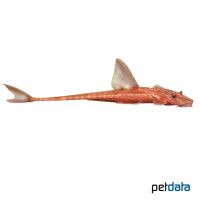Red Lizard Catfish (Rineloricaria sp. 'Red')
| Red Lizard Catfish Rineloricaria sp. 'Red' | |
|---|---|
| Name | Red Lizard Catfish |
| Name Lat. | Rineloricaria sp. 'Red' |
| Synonym | Leliella sp. 'Red', L10a |
| Family | Suckermouth Armoured Catfishes |
| Family lat. | Loricariidae |
| Order | Catfishes |
| Order lat. | Siluriformes |
| Origin | Breeding variety |
| Habitat | Unknown |
| Diet | Omnivore |
| pH | 6.5-7.5 |
| Behavior | Peaceful |
| Keeping | Group |
| Care Level | Moderate |
| Reproduction | Cave spawner |
| Breeding | Moderately difficult |
| Life Span | 8-12 years |
| Protection | No |
| Metric Units | |
| Size | 10 cm |
| Temperature | 24-28 °C |
| Hardness | 2-15 °dH |
| Aquarium | ~ 120 l |
| US Units | |
| Size | 4" |
| Temperature | 75-82 °F |
| Hardness | 36-267 ppm |
| Aquarium | ~ 30 gal |
Distribution and habitat
The Red Witch Catfish is a breeding form for which the parentage is unknown. Possibly they originate from a cross with Rineloricaria lanceolata or a selective breeding form from Leliella heteroptera.
Maintenance
The aquarium should have dense planting with roots, round stones, clay tubes and caves (hiding places) and free sandy areas of fine-grained sand covered with some foliage (oak, sea almond tree). Subdued light and a medium current are ideal.
No ammonia, ammonium and nitrite should be detectable, the nitrate value should not exceed 100 mg/l. To ensure the water quality and oxygen content, a filter and heater adapted to the aquarium size is required, as well as lighting for the species-appropriate day-night rhythm of the animals.
Diet
Their diet consists mainly of insect larvae and small crustaceans. For a balanced diet, feed once a day with a high-quality dry food for loricariids (granules, pellets, chips, tablets) as well as zooplankton, cyclops, daphnia, mosquito larvae, artemia, etc. (live or frozen), plus occasionally some vegetable food, such as algae leaves, zucchini, crushed peas or scalded spinach, which is accepted differently from individual to individual.
Only feed as much as will be eaten within a few minutes, excluding plant foods. Regular and varied feeding promotes health and increases resistance.
Behaviour and compatibility
They are extremely peaceful catfish that are somewhat territorial only during the spawning season and are very suitable for a community tank with other calm fish. It is recommended to keep them in a group of 5-6 animals.
Basically, only compatible fish species with similar demands on water conditions and water temperature should be socialized.
Sex dimorphism
Sexually mature males have odontodes (pointed skin teeth) on the head and pectoral fins, which are absent in females.
Reproduction and breeding
They are cave breeders. Bamboo, clay and PVC tubes or clay caves are suitable for breeding
The female lays the eggs in the cave, which are then fertilized by the male. The male takes over the brood care, guards the cave and fans the eggs with his fins. The larvae hatch after 4-5 days and swim free after 2-3 days, which is the end of the male's brood care. The fry eat soft lettuce and spinach leaves, zucchini slices as well as microworms and Artemia nauplii
In community tanks breeding is hardly possible, because the fry are easy prey.
Important
When trapping, use the finest mesh nets possible to prevent the hard rays of the pectoral fins or the skin teeth (odontodes) from becoming caught on the bone plates, which can cause painful puncture wounds when touched.
The well-being of the fish should be checked regularly. Temperature should be checked daily, pH, hardness and nitrate levels at least every 14 days. Regular partial water changes are recommended, even when contaminant levels have not yet reached the upper limit. Sudden changes in water quality should be avoided. Newly introduced fish must be accustomed slowly to the water in the aquarium.
Further literature can be found in your pet store.
References
Text: Werner Winter; Image: petdata
Source: BMEL (1998): Tierschutzgutachten - Haltung von Zierfischen (Süßwasser); RIEHL & BAENSCH (2004): Aquarien Atlas Bd. 2, Mergus Verlag; ENGELMANN (2005): Zootierhaltung - Tiere in menschlicher Obhut: Fische, Verlag Harri Deutsch
- Gemäß § 21 Abs. 5 Tierschutzgesetz idgF
